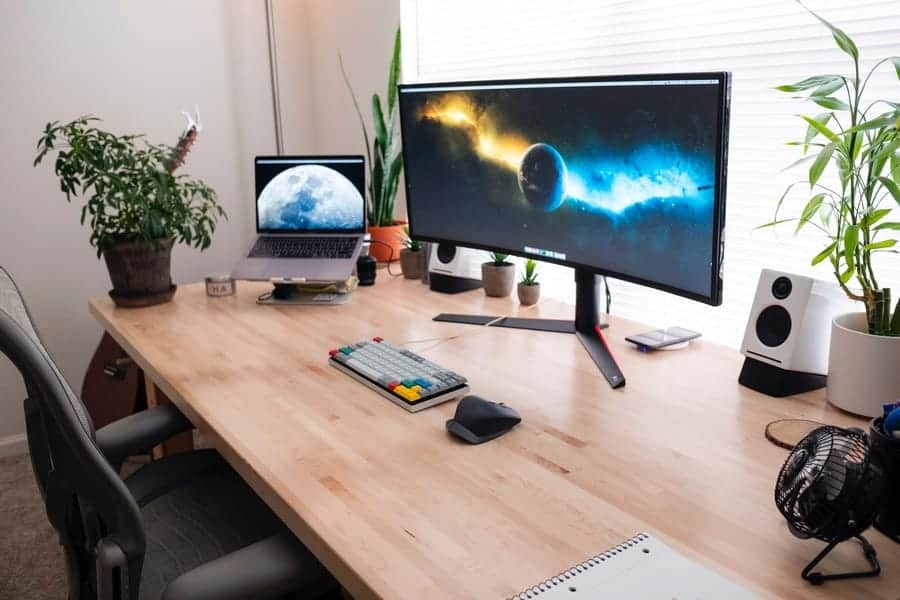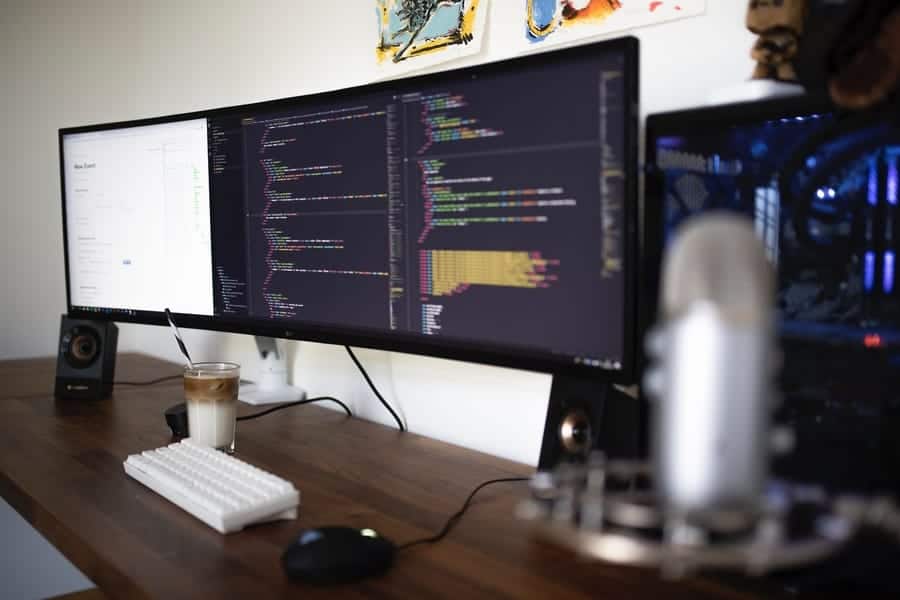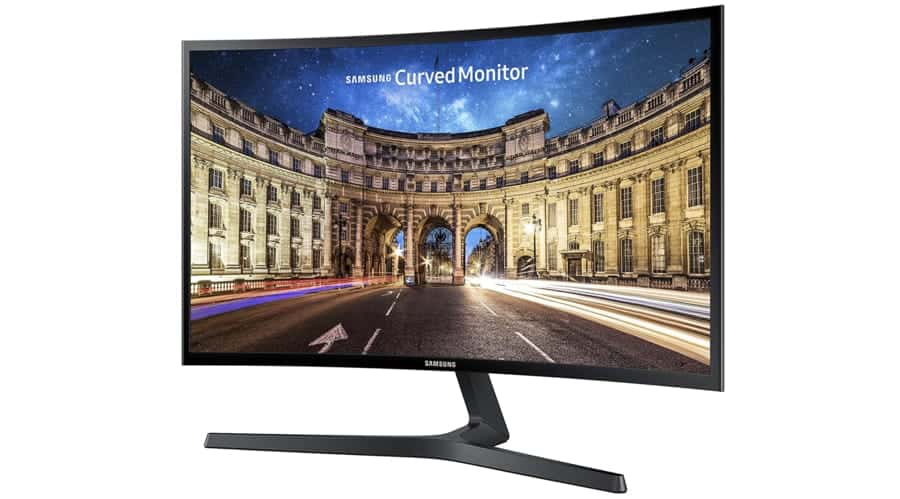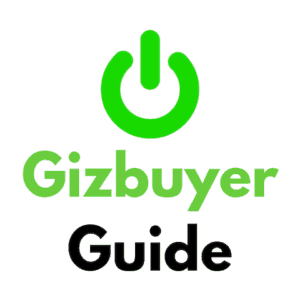
After hours of staring at your computer screen, you notice that your eyes are dry and your head is aching. Day after day you experience the same issue, but think that there is no relief. However, could switching to a curved monitor reduce your eye strain?
Curved monitors can help reduce strain on the eyes by moving the monitor further away from your face, widening your field of view and mimicking the way that your eye absorbs light. Additionally, they produce a clearer image, making it less strenuous for your eye to process images and text.
This article will further detail what causes eye strain, how curved monitors can help with these issues, and what to look for when purchasing a curved monitor.
What is Digital Eye Strain and What Causes It?
Digital eye strain is when your eyes become fatigued from looking at a digital screen for too long. Some of the accompanying symptoms include:
- Blurred vision
- Pain in your neck and/or back
- Dry eyes
- Blurred vision
- Headache
- Difficulty concentrating
- Increased sensitivity to light
Once you are able to identify the symptoms of digital eye strain, it’s essential to understand the factors causing your discomfort. These factors include:
- You blink a lot less while using a computer, which results in dry eye.
- Having the screen too close to your face
- The angle of the screen results in poor posture or difficult reading circumstances
- A bright glare or reflection from your screen
Digital eye strain can be extremely uncomfortable and make focusing on your work very difficult. Luckily, curved monitors help with some of these factors and may prevent you from experiencing the symptoms associated with eye strain.
How Do Curved Monitors Help Prevent Digital Eye Strain?
Curved monitor design isn’t just for looks; it also serves a functional purpose to help reduce eye strain. Let’s look at some of the many ways that curved monitors help address the factors that cause eye strain.
You Can See Your Entire Screen at Once

A curved monitor allows you to view the entire screen, or at least most of the screen, without needing to move your eyes, thanks to your peripheral vision. The screen’s curvature allows your eyes to keep the edges of the screen in focus, resulting in less eye strain.
On flat screens, the flat edges go out of focus, causing you to have to constantly shift your eyes back and forth across the screen. Even though you may not notice, this constant movement can really wear on your eyes.
Curved Monitors Minimize Distortion and Improve Depth Perception
Have you ever noticed how images tend to get blurry or disproportionate towards the edge of your computer screen? This doesn’t happen with curved monitors.
The screen’s curvature also helps improve your depth perception and makes images appear larger and easier to see. The improved clarity really helps reduce the strain on your eyes.
Curved Monitors Work Better with Your Natural Eye Coordination
Since curved monitors mimic your eye’s natural curvature, looking at the screen just appears more natural to your eye. The monitor reduces the workload for your eye by presenting a curved image rather than making your eye do the work of having to process the stimuli from a flat screen.
Additionally, the curvature also mimics the way your eye naturally absorbs light. This results in the glare of the screen being less strenuous for your eyes to take in.
You Have to Move Your Head and Neck Less
Since you can see the entire screen without even really needing to move your eyes, you certainly won’t need to move your head or neck too often. Although you may not realize it while looking at a flat screen, you slightly shift your neck and head to view each end of the screen. This can result in some severe neck pain.
In addition, many people need to use two flat monitors to have the visual space to display everything that they need to see at the same time. Shifting your eyes between the two screens requires a lot of physical movement. Curved monitors are usually quite large, and you should therefore be able to fit everything you need on one screen.
What Should You Look for When Selecting a Curved Monitor?
So you are sold on the idea of trying out a curved monitor to help reduce your eye strain. However, as you start shopping around you will quickly notice that not all curved monitors are created equal. Here are a few key features to look for on curved monitors to help reduce eye strain even further.
Curvature Really Depends on Personal Preference

Curved monitors can vary in curvature. They typically range from 1800R to 4000R, with the lower number indicating a sharper curve. Therefore, a 1800R curvature rating will have a much larger curve than a monitor with a 400R rating.
Curvature really comes down to personal preference. You need to go to a store to see what curvature is most comfortable for your vision. For this reason, we do not recommend purchasing a curved monitor online without first testing it in the store.
Make Sure You Purchase an Ergonomic Monitor
One of the symptoms of eyestrain is neck pain and a headache. While eye strain may be the cause of your discomfort, a poor viewing angle can also cause the same symptoms.
It is imperative to buy a curved monitor that allows you to adjust the angle of the screen. Not only will this improve your viewing experience, but it will also make using the monitor much more comfortable.
Buy a Monitor with a Blue Light Filter
If you work a lot at night, buying a curved monitor with a blue light filter is essential. Not only will it help improve your sleep, but it will also aid in reducing eye strain.
Which Monitor Should I Buy?

While the right monitor for you depends on your personal preferences, two of the best curved monitors available on Amazon are the Sceptre 34-inch Curved UltraWide 21 and the Samsung LC24F396FHNXZA 23.5″ FHD Curved LED-Lit FreeSync Monitor.
Take Breaks from Screen Time
While curved monitors will definitely help reduce your eye strain, they are certainly not a cure-all. If you find yourself still experiencing discomfort from symptoms associated with eye strain after using a curved monitor, ask yourself how long you’ve been staring at a screen?
It’s important to give yourself frequent breaks and look away from your screen every so often. If you take breaks every so often and use a curved monitor, your digital eye strain woes should be a thing of the past.
Sources:
